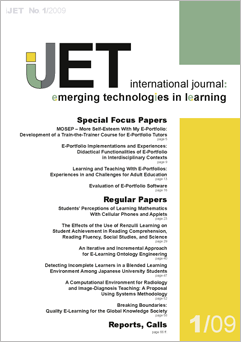Detecting Incomplete Learners in a Blended Learning Environment Among Japanese University Students
DOI:
https://doi.org/10.3991/ijet.v4i1.659Keywords:
Blended learning, Incomplete participants, Access log, DiscriminationAbstract
To examine the feasibility of identifying incomplete participants who had not eventually completed a course in a blended learning environment using current learning behavioral data, access log data of complete and incomplete participants were analyzed. There is a significant difference between the two sets, and the number of accesses correlates with the final test score. Discrimination analysis was conducted using several variables across the learning process, and the ratio of those taking part in online tests was significant. Discrimination performance improved in relation to the number of accesses. The estimation performance was determined for two disparate courses in order to detect incomplete participants.
Downloads
Published
2008-11-15
How to Cite
Nakayama, M., Kanazawa, H., & Yamamoto, H. (2008). Detecting Incomplete Learners in a Blended Learning Environment Among Japanese University Students. International Journal of Emerging Technologies in Learning (iJET), 4(1), pp. 47–51. https://doi.org/10.3991/ijet.v4i1.659
Issue
Section
Papers



